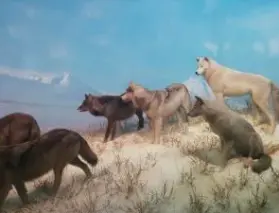 I’m prone to mystical experiences. I’ve had six that were sufficiently intense that I ended up recording them in detail later. And none of those mystical experiences involved any revelation of God. So they weren’t religious experiences – they were irreligious, and I’m still an atheist. Mainly, those experiences involved an intense awareness of the beauty of nature. My most recent mystical experience happened in October 2017, when I was driving through the San Rafael Swell in the middle of Utah. It’s a fantastic area, very remote, rarely visited. And it’s gorgeous, especially near the San Rafael River.
I’m prone to mystical experiences. I’ve had six that were sufficiently intense that I ended up recording them in detail later. And none of those mystical experiences involved any revelation of God. So they weren’t religious experiences – they were irreligious, and I’m still an atheist. Mainly, those experiences involved an intense awareness of the beauty of nature. My most recent mystical experience happened in October 2017, when I was driving through the San Rafael Swell in the middle of Utah. It’s a fantastic area, very remote, rarely visited. And it’s gorgeous, especially near the San Rafael River.
So there I was, on Buckhorn Wash Road, near the river crossing, taking pictures, when the scene became luminous and I fell into ecstasy. The rocks all shone with an inner light. The words from Dawkins at the start of Unweaving the Rainbow came to me, where he says that we are lucky to have opened our eyes on the beauty of the earth. And shortly after that, he says we are “hugely blessed” to see this planet. Dawkins himself seems to have had mystical experiences – though he’s a bit cagey about it. When he looks at really beautiful natural scenes like the Grand Canyon or the Milky Way, he says “I do get a feeling which is probably akin to what religious people feel when they experience what they call a mystical experience.” And during the “Intelligence Squared” debate, he says that during such experiences “I’m overwhelmingly filled with a sense of almost worship, it is not worshipping anything personal anymore than Einstein would have worshipped anything personal. It’s a feeling of sort of an abstract gratitude that I am alive to appreciate these wonders, when I look down a microscope it’s the same feeling, I am grateful to be alive to appreciate these wonders.”
And if you’re experiencing the beauty of nature so intensely that it blows away your sense of self, leaving only tears of joy behind, what are you experiencing? Or even if you have a more ordinary experience of natural beauty, what is it that you see? You see more than just the objects laid out in some scene in front of you. And the beauty of the scene isn’t some merely psychological or subjective experience going on inside your brain. The beautiful patterns in nature really do exist – they are structures outside of your head, arrangements of matter in the world. A sphere is symmetrical regardless of what goes on in your brain, and symmetry is the beginning of beauty.
The spirals in the seeds on the head of a sunflower illustrate the series of Fibonacci numbers. There are lots of great illustrations of the Fibonacci sequence on the web, so I won’t go into it here. The ratios of the Fibonacci numbers are known as the Golden Ratio, which defines the Golden Rectangle and the logarithmic spiral. Again, the web has lots of great illustrations of these mathematical patterns in nature. The logarithmic spiral appears in human faces, in nautilus shells, in hurricanes, and in spiral galaxies. And nature is filled with fractals, with recursively self-similar patterns of extreme beauty. Your brain detects all these mathematical patterns, but the patterns aren’t in your brain. Your brain doesn’t contain sunflower seeds, or hurricanes, or galaxies.
The mathematical structures in nature led the ancient Pythagoreans to argue that nature is just pure mathematics. Nature isn’t made of material things like atoms, it’s ultimately made of purely mathematical objects like numbers. This Pythagorean idea has been picked up by many mathematicians and philosophers. Most recently, the physicist Max Tegmark has argued that physical existence is identical with mathematical existence. Nature is math. To see the beauty of nature is to see its mathematical patterning. And to recognize that this mathematical patterning exists in the natural world, not in your head, and not in some supernatural world, is to affirm the glory of nature.
And to affirm that the patterns in nature really exist out there, in the world and not in our heads, is to affirm that the glory of nature is wild. To recognize the wildness of nature is to recognize that nature does not depend on us. We exist in this wildness, and we depend on it. This wildness is not chaos, it is orderly. It shapes itself, it organizes itself into increasingly complex and increasingly beautiful structures. On earth, evolution by natural selection is a wild process that generates increasingly complex and increasingly beautiful organisms. The wildness at work in the competition between predators and prey shapes them both into exquisitely finely-tuned machines. The cheetah and antelope are both made beautiful by their bloody competition over thousands of generations. It’s wrong to think that natural beauty is pretty or cute or cuddly. The wildness of nature uses conflict, cruelty, brutality, evil, and death as its raw materials. But it shapes those raw materials into wonderful and awesome forms.
The beauty of nature is glorious and ferocious. Its glory and its ferocity point towards its infinity. Even though a sunflower has only finitely many seeds, the Fibonacci numbers run on to infinity. And even though the spiraling winds of a hurricane or spiral arms of a galaxy only go on for finite distances, the logarithmic spiral extends to infinity. Fractal patterns can be nested to infinity. All these infinite patterns are generated by finite laws. The law that generates the Fibonacci numbers is simple: add the last two numbers to make the next number. The law that generates those numbers exists in nature, not in our heads. We didn’t create the Milky Way, and we didn’t arrange its stars into spiral arms. Nature did that long before we even came into existence. We’re lucky to have brains that can understand infinite patterns by understanding their finite laws. Or, as Dawkins said, we’re blessed, and we ought to be grateful. Blessed by what? Blessed by evolution, which has finely tuned our brains to the patterns in nature. Grateful to what? Grateful to evolution, whose wildness has brought us into being.
The infinite patterns in finite things reveal the possibilities of nature. It’s possible for a sunflower to be bigger, and, if it were bigger, then its Fibonacci numbers would be bigger too. It would reveal more of the Fibonacci series. It’s possible for the Milky Way to be larger, and, if it were larger, its logarithmic spiral would extend farther. It’s possible for all these finite things to extend to infinity. And so the finite reveals the infinite, it points to the infinite, and the infinite naturally transcends it. To talk about transcendence, there’s no need to invoke any gods. All you need is natural possibility. Nature is enough. To be overwhelmed by the beauty of nature in mystical experience is to be overpowered by the revelation of infinite beauty.
Learn about Membership in the Spiritual Naturalist Society
__________
The Spiritual Naturalist Society works to spread awareness of spiritual naturalism as a way of life, develop its thought and practice, and help bring together like-minded practitioners in fellowship.












